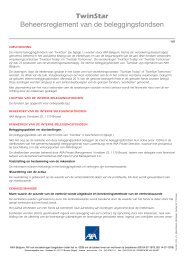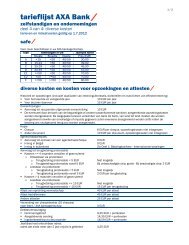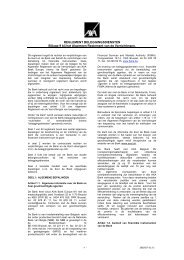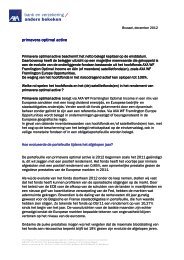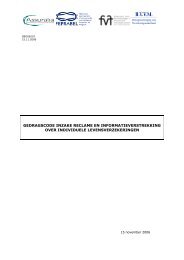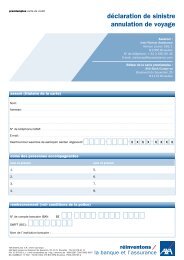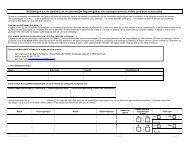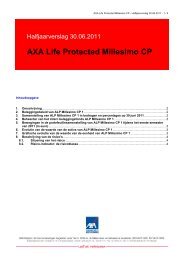AXA WORLD FUNDS A LUXEMBOURG INVESTMENT FUND ...
AXA WORLD FUNDS A LUXEMBOURG INVESTMENT FUND ...
AXA WORLD FUNDS A LUXEMBOURG INVESTMENT FUND ...
You also want an ePaper? Increase the reach of your titles
YUMPU automatically turns print PDFs into web optimized ePapers that Google loves.
securities dealers and listed and unlisted companies is different throughout the world. The laws of some countries<br />
may limit the Sub-Fund’s ability to invest in securities of certain issuers located in those countries.<br />
Different markets have different clearance and settlement procedures. Delays in settlement could result in temporary<br />
periods when a portion of the Sub-Fund’s assets is uninvested and no return is earned thereon. The inability of the<br />
Sub-Fund to make intended securities purchases due to settlement problems could cause the Sub-Fund to miss<br />
attractive investments opportunities. Inability to dispose of Sub-Fund's securities due to settlement problems could<br />
result either in losses to the Sub-Fund, due to subsequent declines in value of the Sub-Fund's securities, or, if the<br />
Sub-Fund has entered into a contract to sell the securities, could result in possible liability to the purchaser.<br />
With respect to certain countries, there is a possibility of expropriation or confiscatory taxation, imposition of<br />
withholding taxes on dividend or interest payments, limitations on the removal of Sub-Funds or other assets of the<br />
Sub-Funds, political or social instability or diplomatic developments, which could affect investments in those<br />
countries.<br />
An issuer of securities may be domiciled in a country other than a country in whose currency the instrument is<br />
denominated. The values and relative yields of investments in the securities markets of different countries, and their<br />
associated risks, are expected to change independently of each other. Investments in sovereign debt obligations by<br />
the Sub-Funds involve risks not present in debt obligations of corporate issuers. The issuer of the debt or the<br />
governmental authorities that control the repayment of the debt may be unable or unwilling to repay principal or<br />
interest, when due in accordance with the terms of such debt, and the Sub-Funds may have limited recourse to<br />
compel payment in the event of a default.<br />
Periods of economic uncertainty may result in volatility of market prices of sovereign debt and in turn the Sub-Fund’s<br />
Net Asset Value. A sovereign debtor’s willingness or ability to repay principal and pay interests in a timely manner<br />
may be affected by, among other factors, its cash flow situation, the extent of its foreign currency reserves, the<br />
availability of sufficient foreign exchange on the date a payment is due, the relative size of the debt service burden to<br />
the economy as a whole, the sovereign debtor’s policy toward international lenders and the political constraints to<br />
which a sovereign debtor may be subject.<br />
3. Risk linked to investments in hedge funds<br />
A limited part of the assets of the concerned Sub-Fund (maximum 10%) is exposed to funds pursuing alternative<br />
strategies. Investments in alternative funds imply certain specific risks linked, for example, to the valuation of the<br />
assets of such funds and to their poor liquidity.<br />
4. Derivatives risk and leverage<br />
The concerned Sub-Fund may use both listed (including but not limited to futures and options) and OTC derivatives<br />
(including but not limited to options, forwards, interest rate swaps and credit derivatives) as part of its investment<br />
strategy for hedging or efficient portfolio management purposes.<br />
These instruments are volatile and may be subject to various types of risks, including but not limited to market risk,<br />
liquidity risk, credit risk, counterparty risk, legal risk and operations risks. In addition, the use of derivatives can<br />
involve significant economic leverage and may, in some cases, involve significant risks of loss. The low initial margin<br />
deposits normally required to establish a position in such instruments permits leverage. As a result, a relatively small<br />
movement in the price of the contract and/or of one of its parameters may result in a profit or a loss that is high in<br />
proportion to the amount of assets actually placed as initial margin and may result in unlimited further loss exceeding<br />
any margin deposited. Furthermore, when used for hedging purposes, there may be an imperfect correlation between<br />
these instruments and the investments or market sectors being hedged.<br />
Transactions in over-the-counter derivatives, such as credit derivatives, may involve additional risk, as there is no<br />
exchange market on which to close out an open position. It may be difficult to assess the value of a position and its<br />
exposure to risk or to liquidate an existing position.<br />
In addition to derivative instruments, the Investment Manager may use repurchase or securities lending agreement in<br />
the investment program of the Sub-Fund. These techniques may increase the leverage of the Sub-Fund and its<br />
volatility. The amount of leverage or borrowings induced by the level of Value-at-Risk may be higher than 100% of<br />
the assets of the Sub-Fund at any time. Moreover, the costs associated with leverage and borrowings will affect the<br />
operating results of the Sub-Fund.<br />
Whether any margin deposit will be required for OTC options and other OTC instruments, such as currency forwards,<br />
swaps and certain other derivative instruments will depend on the credit determinations and specific agreements of<br />
the parties to the transaction, which are individually negotiated.<br />
355





